Best supper should workout Back Dumbbell Shoulder Press,Front-Delt Emphasis,Upright Barbell Row,
Which are the best exercises for overall shoulder development.We let science decide.
The list you're about to read is based on two factors: EMG tests, which measure electrical activity in the deltoids; and an exercise's ability to accommodate load. For example, you may be able to do an overhead barbell press with 185 pounds, but use only 35-pound dumbbells on lateral raises.
More often than not, then, the press is the better choice, even if the lateral raise totally lights up the EMG.
We cite research, when available, but we'll admit up front that this list reflects yet another factor: our best judgment, based on many years of lifting.
For each exercise, we'll tell you why it made the list and how to use it in the context of your workouts. If you disagree with our selections, or think we missed the boat by overlooking your favorite shoulder exercise, let us know in the comments section below!
1. Barbell Push Press:
This press allows you to load up the most weight (or do more reps) above all other overhead pressing moves. It's considered a bit more of a whole-body movement for developing explosiveness, so you lose some of the isolation effect if you do this same movement seated.
With the barbell atop your upper chest, bend your knees slightly and explode upward on the balls of your feet while pressing the bar overhead. Your lower body, core, delts, triceps, and upper pecs are all involved.
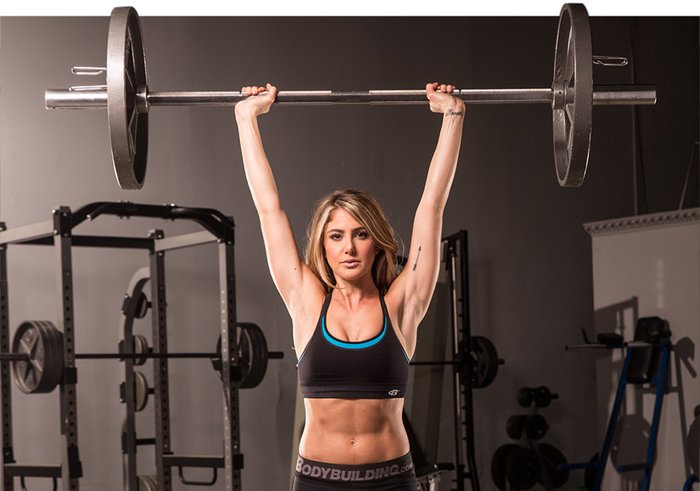
This is considered more of a strength/power movement than a bodybuilding exercise, but building more strength here can help you load up more plates in any number of other lifts. Moreover, doing movements that engage a great deal of muscle mass boost muscle-building hormones better than movements that don't.
Because this variation uses so many muscle groups, don't do it every workout. When you do use it, perform it first in your workout, after warming up well.
For bodybuilders, this isn't the exercise to do every shoulder training day, but it's a great choice for increasing strength and power during an offseason phase.
2. Standing Military Press (Barbell Or Dumbbell)
This is essentially a push press without the extra bit of body English generated through your legs. That makes it a better isolation movement, but this movement still isn't considered an isolation exercise. In fact, it's a highly demanding multijoint overhead press that, because it's not seated, still allows for a bit of momentum as well as increased muscle activation compared to the seated version.
Keep the bar just off your upper chest, and press straight overhead, stopping just short of lockout. Maintain a slight bend in your knees to absorb subtle changes in your center of gravity and relieve some of the stress on your lower back. We included both the barbell and dumbbell here. Research has shown that dumbbells elicit a greater degree of EMG activation, but this usually comes at the expense of the amount of weight lifted.
Be sure to maintain a neutral hip position. Tipping your hips forward or sticking your butt back can wreak havoc with your lumbar spine. If you spend all of your time injured, you'll miss out on the gains!
This is your multijoint overhead press in your workout, so it substitutes for any of the other presses on this list. After warming up well, choose a challenging weight, but not one so heavy that you break form. If your triceps are lagging, grab a pair of dumbbells rather than a barbell; they require less triceps activation.
3. Dumbbell Incline Row
What the heck is a multi joint rowing exercise doing in an article about shoulder exercises? Remember, rowing movements don't just work the "back"; they also involve the rear delts to a significant degree as well.
We didn't realize just how much until we saw research from a 2014 study out of the University of Wisconsin (La Crosse) that compared mostly shoulder exercises to see which had the greatest EMG activation on each of the three delt heads.[2] Of note, this particular row scored just as high as a dumbbell lateral raise for middle-delt activation (and significantly better than dumbbell shoulder presses, cable lateral raises, and even barbell upright rows). For rear delts, that same row scored the same as the seated rear-delt raise in terms of activation but significantly higher than the other eight exercises, though none of them would be considered rear-delt moves.
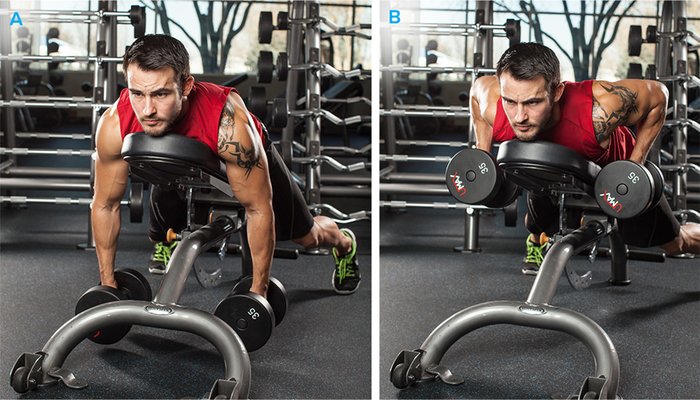
Because the row appears to hit both those heads particularly well, it appears it would be a good addition to your shoulder workout. Because other types of rows weren't considered in the study, it's impossible to say whether they'd be equally as good, but there are surely a number of variations to this movement, including supported T-bar rows and standing (done bent-over) T-bar rows. To best mimic the movement done in the study, which used dumbbells, use a wide grip on the machine.
If you pair back and shoulders on the same training day, this would be a smart exercise to transition between the two body parts. If you include this move with your shoulder workout, do your overhead presses first. Try this before adding single-joint movements.
4. Seated Overhead Dumbbell Press
Switching out the barbell for dumbbells on overhead presses works each side independently, making the move more challenging and requiring more input from stabilizer muscles. Moreover, the range of motion is a bit longer as you press the weights together overhead. (We recommend you don't allow them to touch.)
Going from standing to a seated position further removes your lower body from the lift. Because your upper arms go straight out to your sides during the motion, the middle delts are heavily recruited, with far less stress on the anterior delts than when a barbell is in front of your head.
Do it first in your shoulder session. You'll generally be able to go much heavier on the seated dumbbell press than the standing alternative because of the increased base of support. When going heavy, we recommend a seat back that allows you to press your spine into it for safety. Also, use a spotter to help you get the weights into the starting position and give you a spot (or even a forced rep or two) as you push toward failure.
Raising the weights into position can be harder than it looks. Beginners, try this: When prepping to hoist the dumbbells overhead, grab a weight in each hand, sit down, place the dumbbells on your thighs toward your knees, and quickly lift one knee toward your shoulder to hoist the weight. Repeat using the opposite knee.
5. Seated Overhead Barbell Press
Sitting not only makes it hard to use momentum, it also creates a nice base from which to push the weight. A barbell recruits a greater degree of triceps musculature than dumbbells can. If you've got sore shoulders, stick to keeping the bar in front of you.
When you lower the barbell to the front, notice how your upper arms no longer move directly out to your sides, an indication that the anterior delts are now picking up some of the workload. In fact, this is evident in muscle activation patterns, which demonstrate significantly greater anterior delt activation with a barbell over dumbbells. Some lifters lower the bar behind their head, which more directly stimulates the middle delts. We discourage this approach, which even many longtime lifters find painful.
In your workout: Do these first in your workout, and use challenging weights. Use a seat back for support on heavy sets.
6. Upright Row
There's another family of multi joint movements that also targets the middle delts; upright rows. Each variation—whether on cables, using a Smith machine, or even an EZ-bar or barbell—has its advantages, but none is intrinsically better than the others. Wrist comfort may be the deciding factor for you. Don't take a close grip, which can internally rotate your shoulders; instead, take one in which your upper arms go directly out to your sides.
While a closer grip increases range of motion, a wider grip has been demonstrated to have significantly greater delt activation, minimizing the biceps' role in the movement.
Even though it's a multi joint movement, don't do this first in your workout. Consider doing it after your overhead press. It can even be done as a burnout move at the end of your routine, if you're looking to bring up the middles.
7. Arnold Press
Start with the dumbbells in front of your shoulders with your palms facing you. Press the weights overhead while simultaneously rotating your wrists, so that, in the top position, your palms face forward. Rotate your wrists in the opposite direction when lowering the weights.
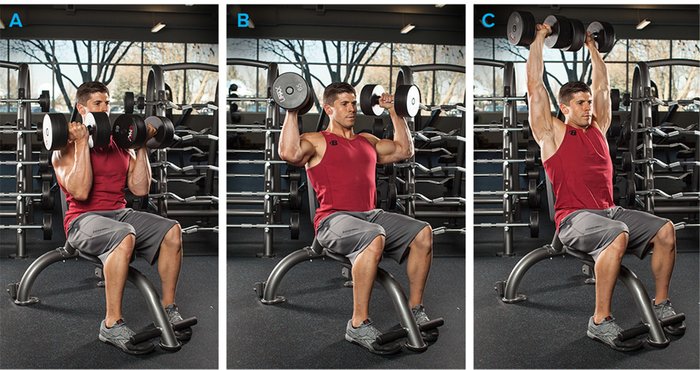
Consider doing these second in your workout after a more basic overhead press. If those overhead presses are heavy, do your Arnold presses with a slightly higher rep range—say, for sets of 10-12 reps.
8. Machine Rear-Delt Fly
There are three movement arcs for single-joint exercises. We put this one before movements for the front and middle heads because the rears are so often undertrained compared to the others. Maintaining rear-delt size and strength relative to the other two is important for both posture and rotator-cuff health.
While you can do a bent-over version with dumbbells to hit the posterior delts, lifters often cheat and sling the weights up with poor control. When doing the rear pec-deck machine, go for a neutral grip—not palms-down—to maximally activate the muscle.
Perform your multi joint movements first in your workout, but if your rear delts are lagging, do this one first in your order of isolation moves.
9. Dumbbell Lateral Raise
This is a great single-joint movement for the middle delts, but they're tougher to master than they seem. Beginners often have trouble learning how to lead with their elbows. They also tend to rest at the bottom of the motion, when in fact it's better to stop the downward arc when their arms are about 30 degrees out to their sides.
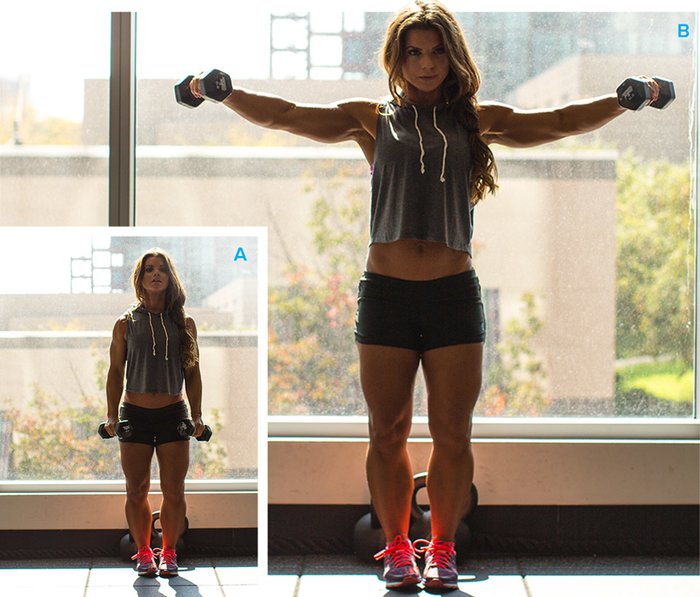
On some sets, take the motion about 30 degrees past shoulder height for a longer range of motion; you may have to sacrifice some weight with this variation. This movement also works well with down-the-rack training, whereby you quickly exchange your dumbbells for lighter ones (about 5 pounds) each time you hit muscle failure.
Position it with other single-joint movements, after multi joint presses, but be aware of the amount of stimulation your middle delts might already be getting. Many of the movements already mentioned target the middle delts especially well. If you want to bring them up, do this exercise first; if your front or rear delts need more work, do this exercise last.
10. Front Dumbbell Raise
Raising your straight arm directly in front of you emphasizes the anterior head of your deltoids. We put this one last because the front delts tend to be disproportionately large among individuals who overdo chest training relative to backside muscles. (And we don't know anybody who'd do that! Cough) So the front delts tend to already be well-developed.
Front raises can be done with a barbell or various cable handles, but we went with the standard dumbbell version. Each side works independently, which can help you not only spot strength imbalances but also correct them. These also calls in more stabilizer activity, so your core has to work that much harder.
In your workout:
Do it during the latter half of your shoulder workout, after your multi joint movements have been completed. Position it in front of (or behind) single-joint movements for the other delt heads, depending on whether your front delts are relatively weaker/smaller (or stronger/larger) than the others.
Back Dumbbell Press :
While holding a dumbbell in each hand, sit on a military press bench or utility bench that has back support. Place the dumbbells upright on top of your thighs.
Now raise the dumbbells to shoulder height one at a time using your thighs to help propel them up into position.
Make sure to rotate your wrists so that the palms of your hands are facing forward. This is your starting position.
Now, exhale and push the dumbbells upward until they touch at the top.
Then, after a brief pause at the top contracted position, slowly lower the weights back down to the starting position while inhaling.
Repeat for the recommended amount of repetitions.
Variations: You can perform the exercise standing or sitting on a regular flat bench. For people with lower back problems, the version described is the recommended one. which is to start holding the dumbbells with a supinated grip (palms facing you) in front of your shoulders and then, as you start pushing up, you align the dumbbells in the starting position described on step 3 by rotating your wrists and touch the dumbbells at the top. As you come down, then you would go back to the starting position by rotating the wrist throughout the lowering portion until the palms of your hands are facing you. This variation is called the Arnold Press. However, it is not recommended if you have rotator cuff problems.
Front-Delt Emphasis:
If you like to train chest, you probably already have well-developed front delts. After all, they're engaged in all your pressing moves, especially inclines. But relatively weak anterior delts can be holding you back from a bigger chest, so here's a front-delt-focused workout you can use in place of your regular shoulder routine.
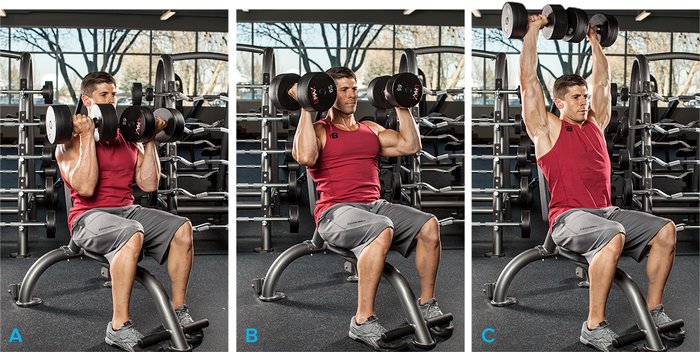 |
Separate your chest and shoulder workouts by at least 48 hours in your training split to ensure they're fully recovered between workouts.
Upright Barbell Row:
 |
Now exhale and use the sides of your shoulders to lift the bar, raising your elbows up and to the side. Keep the bar close to your body as you raise it. Continue to lift the bar until it nearly touches your chin. Tip: Your elbows should drive the motion, and should always be higher than your forearms. Remember to keep your torso stationary and pause for a second at the top of the movement.
Lower the bar back down slowly to the starting position. Inhale as you perform this portion of the movement.
Repeat for the recommended amount of repetitions.
Variations: This exercise can also be performed using a straight bar attached to a low pulley and it can also be performed using dumbbells, though this later exercise should be reserved by people that are well
Building A Foundation:
Greater Deltoids Definition:
Lifting light weights for high reps is no longer considered the best approach to better defining the deltoids. This workout focuses on a stimulus to boost size first (moderate weight for moderate reps), then a high volume of work combined with super sets to increase the number of calories burned both during the workout and after (called excess post-exercise oxygen consumption, or EPOC). You'll be moving faster and really feeling the muscle burn.familiarized with correct execution.
 |
Building A Foundation:
This basic routine consists of an overhead press plus a single-joint move for each of the three delt heads. When possible, start with machines to learn the feel of the motion before graduating to free weights. So long as you adjust the machine for your body mechanics, you're constrained to the proper motion.
Though jumping over to free weights will prove to be a challenge for your coordination initially, they're better for muscle-building in the long term. Start light to focus on proper form first. Add weight only when you can fully control the motion.
Middle-Delt Growth:
Making your shoulders appear wider requires emphasizing the middle delts. Doing so helps broaden your V-taper while creating the illusion of a smaller waist. The key to the workout, of course, is to do more movements that target the middle delts.
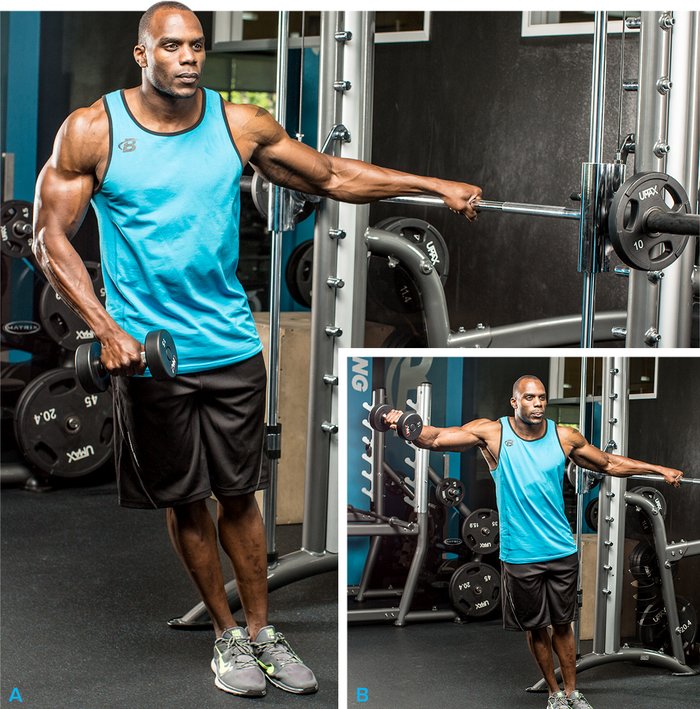 |
Besides additional exercises, you'll want to use slightly different angles for a slightly different training stimulus, and do middle-delt exercises earlier in your routine, when your strength levels are highest. You can alternate this routine with a more balanced delt workout (such as the mass workout) in your weekly split.
Rear-Delt Growth:
Rear delts are commonly lagging for novices and bodybuilding pros alike. Simply put, they don't get as much stimulation, given that the front and middle delts are involved in chest- and shoulder-pressing moves. While the rears are called into action on back day, all too many lifters focus on mirror muscles.
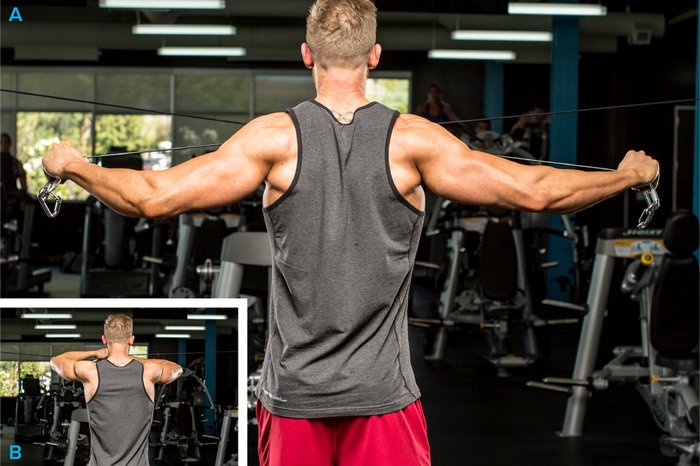 |
If your rears are in arrears, just follow this routine for 4-8 weeks—or alternate with a more balanced shoulder routine—to help bring them up.
Pre-Exhaust Your Delts:
As with chest, the triceps can sometimes be a limiting factor in shoulder training, especially on your presses. If your triceps are always giving out before your shoulders feel completely stimulated, you'll never be able to take the delts to total failure on those multijoint exercises. This pre-exhaust technique addresses that issue. Here, you fatigue the delt heads with single-joint movements first, then do multijoint overhead presses while your triceps are still strong. That way, your delts should reach failure before your triceps do.
Even though you'll be stronger with the single-joint exercises because you're doing them first, avoid the temptation to go too heavy, because of the added stress to your elbows joints. Also, because you're already highly fatigued by the time you get to your presses, a machine version might be a bit safer.
By flip-flopping the order of the exercises, you'll be a little stronger on your single-joint movements but a bit weaker on your overhead presses, so adjust your weights accordingly.
Dumbbell Bent-Over Raise:
 |
Dumbbell Bent-Over Raise |
The bent-over lateral raise is an isolating exercise that targets the rear Deloitte head and develops strength and density throughout the shoulder region. Grab a set of dumbbells and allow your arms to hang down by your sides with your palms facing towards each other.
Dumbbell High Pull:
 |
Dumbbell High Pull |
Hold dumbbells in front of your thighs and bend your knees and hips so the weights hang just above your knees.
Explosively extend your hips as if jumping and pull the weights up to shoulder level with elbows wide apart, as in an upright row.
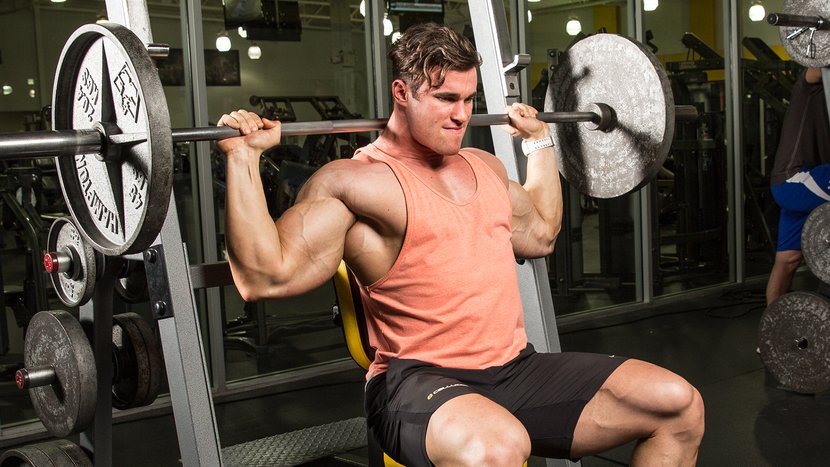


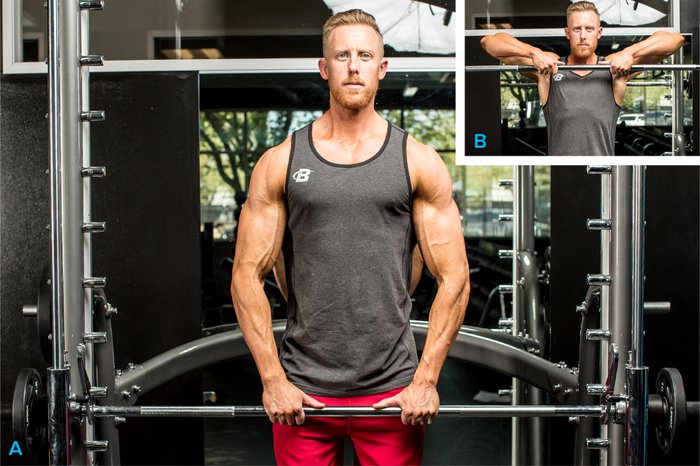


gym equipment manufacturer in India
ReplyDeleteThanks for the detailed blog. It gives a meaningful idea. You can also visit Fittness Freaks. to get many exercises at the home that you are looking for.
ReplyDeleteFor more detailed visit:Fitness Exercises
This is my first time visit to your blog and I am very interested in the articles that you serve. Provide enough knowledge for me. Thank you for sharing useful and don't forget, keep sharing useful info: clenbuterol France
ReplyDeleteThank you for this valuable information, I hope it is okay that I bookmarked your website for further references.
ReplyDeleteWorkout Tank top
Add these eye-catching packaging of incense oriental perfumes to your collection of designer scents and its authentic fragrance will truly match with your bold personality.
ReplyDeleteBest Perfume in Germany
TÜL PERDE MODELLERİ
ReplyDeleteNumara onay
mobil ödeme bozdurma
nft nasıl alınır
Ankara evden eve nakliyat
TRAFİK SİGORTASİ
DEDEKTOR
KURMA WEBSİTESİ
Ask kitaplari
Smm panel
ReplyDeleteSmm Panel
İş ilanları blog
İnstagram takipçi satın al
Hirdavatciburada.com
WWW.BEYAZESYATEKNİKSERVİSİ.COM.TR
SERVİS
Tiktok jeton hilesi